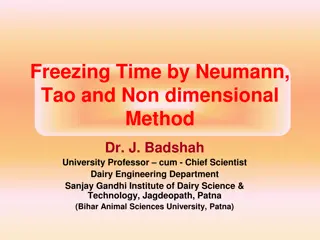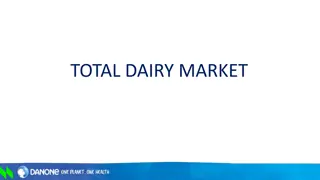Efficient Methods for Butter Manufacturing in Dairy Process Engineering
Explore the principles of butter making including churning, emulsification, and continuous butter making methods like the Fritz Process and Alfa Process. Learn about the benefits of continuous butter making such as cost-effectiveness, hygiene, quick production, and automation integration. Discover batch methods using rotating churns for butter production.
Download Presentation

Please find below an Image/Link to download the presentation.
The content on the website is provided AS IS for your information and personal use only. It may not be sold, licensed, or shared on other websites without obtaining consent from the author.If you encounter any issues during the download, it is possible that the publisher has removed the file from their server.
You are allowed to download the files provided on this website for personal or commercial use, subject to the condition that they are used lawfully. All files are the property of their respective owners.
The content on the website is provided AS IS for your information and personal use only. It may not be sold, licensed, or shared on other websites without obtaining consent from the author.
E N D
Presentation Transcript
Butter Manufacturing Machines Dairy Process Engineering (DTE -212) Dr. J. Badshah University Professor cum - Chief Scientist Dairy Engineering Department Sanjay Gandhi Institute of Dairy Science & Technology, Jagdeopath, Patna (Bihar Animal Sciences University, Patna)
CONTINUOUS BUTTER MAKING INTRODUCTION Highly economical: Due to reduced labour cost, reduced power consumption. More hygienic: Because it is processed under closed system, no manual handling is necessary contamination. and no chance for air borne Quicker: Butter can be produced in a span of few minutes from cream. Efficiency: Large volume can be easily produced at high efficiency. Automation: Can be connected directly to packaging lines.
Principles of Butter Making Churning or frothing: In this method, butter grain is formed by aggregation of the fat globules under the action of air present in the cream. During churning, air is beaten into the cream and is dispersed into small bubbles. The fat globules touch these air bubbles, often spread part of their membrane substances and some of their liquid fat over the air water interface, and become attached to the bubbles. They thus coalesce and adhering together. In this way small fat clumps are formed. One bubble catches several globules. This involves the use of high-speed beaters to destabilize the fat emulsion in chilled cream, and cause the formation of grains of butter in few seconds. The buttermilk is then drained out and butter granules are worked in kneading section consists of screw type kneader. Concentration and phase Reversal: In this method the concentrated cream will be subjected to combined effects of cooling and working and bring about a direct conversion of cream to butter. Thus it by-passes the butter grain stage. Emulsification: In this process, liquid butter fat and serum are emulsified and emulsion is cooled and worked to form butter.
Batch method using rotating churns The shape is mostly cylindrical with front opening, cone with cylinder, single cones and double cone etc. The churn is short in length and large in diameter. Baffles are fitted internally to improve agitation. In some designs, ribbed rollers are fitted through which butter grains pass. The fittings like air vent, sight glass, butter milk outlet, opening for cream inlet, and outlet for butter are mounted on barrel. The degree of mixing depends on the amount of cream in the churn and on the rate of revolution. Too low a rate will not give sufficient turbulence and with too high a speed there is the danger that the centrifugal force (m 2R) will exceed the gravitational force (mg) and that the cream will stick to the periphery and rotate there with drum. The best condition for churning i.e. maximum turbulence, are achieved when the force of gravity just exceeds the centrifugal force. i.e. m 2R < mg (2 n)2R < g Or n < [g/R]1/2. 1/2 1/(2 R)
Methods of Continuous Butter Making The Fritz Process (Churning or frothing Principle) Contimab Process (Churning or frothing Principle) Alfa Process (Concentration and phase Reversal) Cherry-Burrell Gold n Flow Process ( Emulsification and cooling)
The Fritz Process Machines operating on Fritz process or floatation churning, where accelerated churning and working takes place. Few examples of this type are known as Westfalia Separator (West Germany), Contimab (France), HMT (India) and Masek (Czechoslovakia). contains three main parts, viz. Churning cylinder, draining and washing cylinder and worker. Capacity is up to 10000 kg/h. Preparation of cream Churning the cream :Churning cylinder is a four-armed beater running at 250 2800 rpm with a wall clearance of 2-3mm. The speed can be varied as required. The pockets in the churning cylinder impart extra turbulence to the film of cream thereby enhancing the butter making action and improving the yield. Butter granules are formed within a 3-5 seconds. The cylinder is cooled by cold water circulation during the operation. Second churning cylinder rotates at 10-25 rpm or stationary cylinder with paddle-bearing shafts rotates at 34 rpm it is also cooled.
The Fritz Process Butter milk separation and draining: First unit is Separating cylinder with its welded ribs. The next unit is the buttermilk draining cylinder. This cylinder is perforated and provided with beater studs. Buttermilk gets separated and drained through holes. Washing the granules: Perforated washing section with washing sprays Working and texturizing :The washed butter grains fall into twin worm butter worker (two contra rotating screws). They are inclined and forces butter through number of perforated plates arranged in series which gives the fine dispersion of water. The process is assisted by mixing vanes, situated between plates. The butter worker can be operated at either of two fixed speed of approximately 65 and 30 rpm. In this section, there are provisions for salt and colour addition, and moisture corrections. The butter comes out in the form of a continuous stream, its shape depending upon that of the outlet spout
Contimab Process Two major working sections are provided, one is wet and another one is dry. Rpm of Churning Cylinder 600-800 and time of churning : 1-2 sec. In wet working section washing and cooling of butter granules and removal of buttermilk takes place. In dry working section, butter is further worked and reduces the moisture content to 13 to 14%. Further butter travels to dosing section, where adjustment of salt and moisture will be happen. At the end vacuum chamber is provided to reduce the air content of the butter.
Schematic Diagram of Contimab Process 1. Churning cylinder 2. Separation section 3. Squeeze-drying section or First working section 4. Second working section
Alfa Process It is a concentration and phase inversion process by cooling. Cream of 30% fat is pasteurized at 90 C, degassed, cooled to 45 50 C and separated at this temperature in a cream separator to 82% fat. The cream, which is still in the form of oil in water emulsion, but it is almost the composition of butter. In this cream fat globules are so closely packed that their fat globule membranes are in contact with each other. As fat crystallizes and fat crystals perforate the fat globule membrane and free fat is released out. Rubbing together of the fat globules helps this process as they move in the cooler. Thus phase inversion takes place and water-in-oil emulsion (butter) is formed. It contains all the fat globule membrane material, thus it has high phospholipids content and no buttermilk is produced in this process. The Alfa process was developed in Germany and Sweden. The Alfa-Laval (Sweden) butter making process consists of the following major steps (McDowell, 1953).
Cherry-Burrell Goldn Flow Process The process starts with 18 C cream that is pumped through a high- speed destabilizing unit and then to a cream separator, from which a 90% fat plastic cream is discharged. Destabilization is a process of packing small fat globules together to form large ones. Destabilizing unit consists of a perforated blade travelling at high speed, beating chamber, an adjustable hold back valve and an air inlet valve. The blade travelling at high speed packs the fat globules together by mechanical force. The adjustable hold-back valve insures that the cream is held in beating chamber long enough. It is then vacuum pasteurized and held in agitated tanks, wherein color and salt are added























